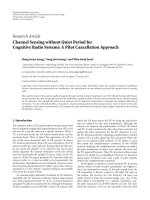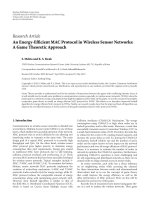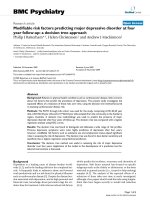Adaptive scheduling systems a decision theoretic approach
Bạn đang xem bản rút gọn của tài liệu. Xem và tải ngay bản đầy đủ của tài liệu tại đây (1.06 MB, 202 trang )
ADAPTIVE SCHEDULING SYSTEMS:
A DECISION-THEORETIC APPROACH
NUR AINI MASRUROH
NATIONAL UNIVERSITY OF SINGAPORE
2009
ADAPTIVE SCHEDULING SYSTEMS:
A DECISION-THEORETIC APPROACH
NUR AINI MASRUROH
(B.Eng., Gadjah Mada University, Indonesia)
(M.Sc., The University of Manchester, UK)
A THESIS SUBMITTED
FOR THE DEGREE OF DOCTOR OF PHILOSOPHY
DEPARTMENT OF INDUSTRIAL AND SYSTEMS
ENGINEERING
NATIONAL UNIVERSITY OF SINGAPORE
2009
ii
ACKNOWLEDGEMENT
I would like to express my gratefulness and sincere thanks to Associate
Professor Poh Kim Leng for his valuable supervision, appreciable comments and
constant support throughout the research period. I would also like to thank Dr Wikrom
Jaruphongsa, Associate Professor Lee Loo Hay and Dr Ng Kien Ming who served on
my thesis committee and provided me many helpful comments on my research.
Moreover, I acknowledge all the faculty members in the Department of Industrial and
Systems Engineering, from whom I have learnt a lot from the course work, discussion,
and seminars.
I would like to thank to the members of Bio-medical Decision Engineering for
the valuable discussion and suggestion on my research. Sincere thanks are dedicated to
the members of Systems Modeling and Analysis Laboratory for the friendship and help
throughout my research.
Special appreciations are for my Father, Mother, and my sister Kun Farihah for
their unceasing love, comfort and support throughout the whole of my study. I cherish
the warm companionship of my Indonesian friends in Singapore. A deep gratitude is
for my beloved husband Estiko Ari Wibowo who have sustained my being and
selflessly sacrificed for the completion of this thesis. Last but not least, many thanks
for my daughters Farah Aqila Rusyda and Hanin Ammara Rusyda. I love you more
than you imagine.
iii
TABLE OF CONTENTS
TITLE PAGE i
ACKNOWLEDGMENT ii
TABLE OF CONTENTS iii
SUMMARY vii
LIST OF TABLES ix
LIST OF FIGURES xi
LIST OF NOTATIONS xv
1. Introduction 1
1.1 Background and Motivation 1
1.2 Decision Theoretic Based Scheduling Systems 4
1.2.1 Overview 4
1.2.2 Scope 8
1.2.3 Objective 9
1.2.4 Methodology 10
1.3 Contributions 11
1.4 Organization of the Thesis 13
iv
2. Literature Review 16
2.1 Recent Advancement in Scheduling Under Uncertainties 16
2.1.1 Proactive Scheduling 20
2.1.2 Completely Reactive Scheduling 22
2.1.3 Predictive-Reactive Scheduling and Proactive-Reactive Scheduling 26
2.2 Decision Analysis Techniques 29
2.3 Influence Diagram: an Overview 32
3. Decision Theoretic Approach to Job-Shop Scheduling 39
3.1 Model Definition 39
3.2 Solution Algorithm 47
3.3 Model Effectiveness 54
4. Reactive and Robust Scheduling 58
4.1 Robustness Measure 58
4.2 Reactive Scheduling Model 61
4.3 Myopic Approach 62
4.4 Case Study 63
5. Probability Assessment 78
5.1 Scoring Method: A Way to Quantify Disruptions 80
5.2 A Worked Example 87
v
6. Shop-Floor Evaluation Model 95
6.1 Structure Learning 97
6.2 Parameter Learning 100
6.3 Trigger Value 101
6.4 Illustration on Application 104
6.4.1 Experimental Design 104
6.4.2 Assigning Utility Values, Trigger Value, and Setting Evidence 107
6.4.3 Real Time Application 111
6.4.4 Expanding the Network: the Inclusion of Indirect Factors 115
6.4.5 Integrating Direct and Indirect Factors 116
6.4.6 Sensitivity Analysis 118
6.4.6.1 Changing Factors’ Inputs 118
6.4.6.2 Changing the Penalty-Holding Cost ratio and the Tightness Factor, K,
of the Due Date Assignment 120
7. Proactive-Reactive Scheduling with Periodic-Event-Driven Review
Technique 122
7.1 Performance of the Proposed Method 127
8. Conclusion and Future Works 135
8.1 Conclusion 135
8.2 Possible Future Research 139
vi
REFERENCES 141
APPENDIX A Selected Literature on Scheduling Under Uncertainties 153
APPENDIX B Production Data for the Case Study 163
APPENDIX C Score-Cycle Time Deviation Relationship 167
APPENDIX D Proactive-Reactive Scheduling with Periodic-Event-Driven Review
Technique for Various Problem Sets 173
APPENDIX E Flowcharts 182
vii
SUMMARY
Current research on machine scheduling focuses on scheduling under
uncertainties as the static scheduling remains unusable in practice. However, the
inclusion of disruptions into the schedule making processes increases the complexity
of the schedule. Thus, the use of mathematical model becomes not practical. The
disruptions to the shop-floor can be caused by many factors and their impact to the
schedule is probabilistic. Consideration of factors that probabilistically cause the
disruption to the floor in the schedule making processes becomes our intention.
This thesis focuses primarily on the job-shop problems. The main concern is
the effectiveness, reactivity, usable, and robustness of the schedule generated.
Decision-theoretic approach is used to model the proposed scheduling system. It
facilitates the inclusion of all variables that may influence the current shop-floor
conditions into a single framework and also facilitates the inter-dependency among
variables. The uncertainties are represented through probabilities. The scheduling
system is modeled in Influence Diagram (Decision Network). Composite dispatching
rules technique is used as dispatching rules are the most preferred approach to job-shop
scheduling in industry. This is to ensure the usability of the proposed method. Three
approaches in solving the job-shop problem are proposed.
The first approach is the proactive schedule, an offline performed and static
schedule. The static model is used to test the effectiveness of the decision-theoretic
based scheduling system before introducing any disruptions. The result shows that by
viii
reducing into deterministic model the proposed model outperforms some benchmark
algorithms with makespan as the objective.
The second model is the reactive scheduling system. This time dependent
scheduling system is basically the application of the static model in the stochastic
environment. The concept of Dynamic Influence Diagram and Temporal Influence
Diagram is adopted. The robustness test confirms that the proposed method is more
robust than the single rules.
The third model is the hybrid approach of proactive-reactive scheduling with
periodic-event-driven rescheduling policy. This model consists of three parts that have
been developed; proactive model as the baseline schedule, reactive model as the online
part, and the system evaluation as the when-to-schedule policy. In the proposed
when-to-schedule policy, schedule revision is carried out periodically and based on the
current level of disruptions. A method to quantify the disruptions is proposed. The
experimental results show that the proposed hybrid approach enables cycle time to be
as low as the totally reactive scheduling but allows the reduction of the number of
evaluations significantly. Consequently, using this approach the shop-floor
nervousness can be minimized.
ix
LIST OF TABLES
Table 3.1 Machine requirement (process times) for the worked example (Subramaniam,
2000a) 44
Table 3.2 Utility values 54
Table 3.3 Parameter estimation 55
Table 3.4 Makespan for the single rules and the proposed method 56
Table 3.5 Makespan for some square job-shop problems 57
Table 4 .1 ANOVA result 69
Table 5.1 DOE: extreme values 89
Table 5.2 Sensitivity analysis with entropy reduction 93
Table 6.1 Average total cost 113
Table 6.2 ANOVA results 113
Table 6.3 Sensitivity analysis with entropy reduction for the system evaluation 119
Table 6.4 Rescheduling point for various penalty-holding cost ratio and the tightness
factor, K, of the due date assignment … …………………. ……………121
Table 7.1 Performance of some scheduling schemes with uniform jobs inter-arrival time
and mean time between failures of the machines for 6x6 problem 129
Table 7.2 Performance of some scheduling schemes with exponential job inter-arrival
time and mean time between failures of the machines for 6x6 problem 130
Table A.1 Selected papers on scheduling under uncertainties 154
Table B.1 Machine requirement (processing time) for the 4x4 problem 163
x
Table B.2 Machine requirement (processing time) for the Muth and Thompson 6×6
problem (Muth and Thompson, 1963) 163
Table B.3 Machine requirement (process times) for the Muth and Thompson 10×10
problem (Muth and Thompson, 1963) 164
Table B.4 Machine requirement (process times) for the 10×10_zhou problem (Yang and
Wang, 2001) 165
Table B.5 Machine requirement (process times) for the Muth and Thompson 5×20
problem (Muth and Thompson, 1963) 166
Table D.1 Trigger values for the problem sets 174
Table D.2 Performance of some scheduling schemes with uniform job inter-arrival time
and mean time between failures of the machines for 4x4 problem 175
Table D.3 Performance of some scheduling schemes with uniform job inter-arrival time
and mean time between failures of the machines for 10x10 problem 176
Table D.4 Performance of some scheduling schemes with uniform job inter-arrival time
and mean time between failures of the machines for 5x20 problem 178
Table D.5 Performance of some scheduling schemes with uniform job inter-arrival time
and mean time between failures of the machines for 10x10_zhou problem
179
xi
LIST OF FIGURES
Figure 1.1 Structure of the thesis 15
Figure 2.1 Classes of scheduling under uncertainties 19
Figure 2.2 Influence Diagram and the corresponding decision tree: an example. (a)
Viewed as icon; (b) Viewed as bar chart; (c) Decision tree 35
Figure 3.1 ID for job-shop scheduling systems; (a) shown as icon; (b) shown as bar chart
42
Figure 3.2 Basic decisions with processing time difference as the only variable to
consider 45
Figure 3.3 Basic decisions with processing time difference and number in next queue as
the variables to consider 46
Figure 3.4 Orthogonal design for 3 factors with centre point 52
Figure 4.1 Box plot for 4×4 problems; mean total cost for various mean job inter arrival
time (IAT) 66
Figure 4.2 Box plot for 6×6 problems; mean total cost for various mean job inter arrival
time (IAT) 66
Figure 4.3 Box plot for 10×10 problems; mean total cost for various mean job inter
arrival time (IAT) 67
Figure 4.4 Box plot for 10×10_zhou problems; mean total cost for various mean job
inter arrival time (IAT) 67
xii
Figure 4.5 Box plot for 5×20 problems; mean total cost for various mean job inter arrival
time (IAT) 68
Figure 4.6 One way ANOM (rule 1=DA, rule 2=DA myopic, rule 3=FIFO, rule 4=SPT,
rule 5=MWKR, rule 6=NINQ) 73
Figure 4.7 Robustness for 4×4 problem 74
Figure 4.8 Robustness for 6×6 problem 75
Figure 4.9 Robustness for 10×10 problem 75
Figure 4.10 Robustness for 10×10_zhou problem 76
Figure 4.11 Robustness for 5×20 problem 76
Figure 5.1 Simplified ID; (a) shown as icon; (b) shown as bar chart 81
Figure 5.2 Score-cycle time deviation relationships for 6×6 job-shop problem 86
Figure 5.3 Cumulative probability distribution of “process” node 90
Figure 5.4 Cumulative probability distribution of “shop-floor uncertainties” node 91
Figure 5.5 Bayesian Network for the initial condition; shown as bar chart 91
Figure 5.6 Bayesian Network after setting “shop-floor uncertainties” to be high 92
Figure 6.1 ID for evaluating shop-floor uncertainty; viewed as bar chart 100
Figure 6.2 Simplified ID; shown as bar chart 102
Figure 6.3 Flowchart for the system evaluation 105
Figure 6.4 ID for the initial condition; shown as bar chart 108
Figure 6.5 ID shown as bar chart after setting evidence; (a) “new jobs” (b) “machine”
node 109
Figure 6.6 Relationship between job inter-arrival time and total cost 110
xiii
Figure 6.7 Simplified ID for the schedule interactions; initial condition 116
Figure 6.8 Completed ID for initial condition 117
Figure 6.9 Changing the probability of new jobs and promotion 118
Figure 7.1 Schematic diagram of the proposed proactive-reactive model 123
Figure 7.2 Box plot for uniform job inter-arrival time and MTBF 130
Figure 7.3 Box plot for exponential job inter-arrival time and MTBF 131
Figure 7.4 Robustness for uniform job inter-arrival time and MTBF for the 5 scheduling
schemes for the 6x6 problem 132
Figure 7.5 Robustness for exponential job inter-arrival time and MTBF for the 5
scheduling schemes for the 6x6 problem 133
Figure 7.6 Number of rescheduling events versus the total cycle time deviations 133
Figure 8.1 Supply chain structure (Kreipl et al, 2006) 139
Figure C.1 Score-cycle time deviation relationship for 4×4 problem 168
Figure C.2 Score-cycle time deviation relationship for 10×10 problem 169
Figure C.3 Score-cycle time deviation relationship for 10×10_zhou problem 170
Figure C.4 Score-cycle time deviation relationship for 5×20 problem 172
Figure D.1 Robustness for uniform job inter-arrival time and MTBF for the 5 scheduling
schemes for the 4x4 problem 175
Figure D.2 Robustness for exponential job inter-arrival time and MTBF for the 5
scheduling schemes for the 4x4 problem 176
Figure D.3 Robustness for uniform job inter-arrival time and MTBF for the 5 scheduling
schemes for the 10x10 problem 177
xiv
Figure D.4 Robustness for exponential job inter-arrival time and MTBF for the 5
scheduling schemes for the 10x10 problem 177
Figure D.5 Robustness for uniform job inter-arrival time and MTBF for the 5 scheduling
schemes for the 5x20 problem 178
Figure D.6 Robustness for exponential job inter-arrival time and MTBF for the 5
scheduling schemes for the 5x20 problem 179
Figure D.7 Robustness for uniform job inter-arrival time and MTBF for the 5 scheduling
schemes for the 10x10_zhou problem 180
Figure D.8 Robustness for exponential job inter-arrival time and MTBF for the 5
scheduling schemes for the 10x10_zhou problem 180
Figure E.1 Flowchart for DA procedure to select the job in queuing list 182
Figure E.2 Flowchart for development of system evaluation model 183
Figure E.3 Flowchart for scoring method 184
Figure E.4 Flowchart for proactive – reactive scheduling technique 185
xv
LIST OF NOTATIONS
AHP Analytic Hierarchy Process
ANOM Analysis of Means
ANOVA Analysis of Variance
BD Machine Breakdown
BN Bayesian Network
DA Decision Analysis
DOE Design of Experiment
DID Dynamic Influence Diagram
FIFO First In First Out
GLM General Linear Model
IAT Inter Arrival Time
ID Influence Diagram
LIFO Last In Last Out
LOPNR: Least Operations Remaining
LPT Longest Processing Time
LWKR Least Work Remaining
MOPNR Most Operations Remaining
MTBF Mean Time Between Failure
MTTR Mean Time To Repair
MWKR Most Work Remaining
NINQ Number In Next Queue
PR-ED(pred) Periodic Review–Event Driven with predictive baseline schedule
xvi
PR-ED(pro) Periodic Review–Event Driven with proactive baseline schedule
PT Processing Time
RW Rework
SPT Shortest Processing Time
TID Temporal Influence Diagram
1
Chapter 1
INTRODUCTION
1.1 Background and Motivation
Scheduling is a very important daily practical problem. Significant increase in
revenue gain can be obtained through applying better scheduling systems. Thus, it is a
rich research domain in the manufacturing area. One of the important machine
configurations is the job-shop model. The general job-shop problem is to schedule
production times for N jobs on M machines. Each job has its own route. This problem
is extremely complex and all purpose solution algorithms for solving the general
job-shop problem do not exist. Some scholars categorized the job-shop problem as an
NP-complete problem (Garey and Johnson, 1979; Adams et al, 1988) and the others
categorized as NP hard (Leon et al, 1994; Tay and Ho, 2008).
In many systems, the schedules are developed under the assumption of information
certainty, and also normally without the consideration of unexpected events. The key
assumption that is commonly used to perform the predictive scheduling - the schedule
that is performed offline based on the available information - is that the system works
in a deterministic environment. However, in the real world the probability of actually
executing the offline schedule exactly as planned is low (Davenport and Beck, 2000).
The field study done by McKay et al (1988) concludes that the static model is
unusable in practice due to the persistence of system disturbances. These dynamic
2
disturbances increase the complexity of the problem. Leon et al (1994) stated that after
adding the randomness into the job-shop problems, generating the optimal schedule is
not practical.
In order to avoid further problems that may be caused by “surprises” due to the
occurrence of unpredicted events, it is necessary to consider the uncertainty during the
pre-scheduling process. However, the inclusion of uncertainty makes the measurement
of schedule quality harder (Aytug et al, 2005). Yang and Yu (2002) stated that even the
robust version of single machine problem with minimizing total completion time
subject to uncertain processing time is categorized as an NP-complete problem. In
addition, Leus and Herroelen (2005) also stated that the single disruption stability
problem on a single machine is ordinarily NP-hard. Practically the shop-floor
condition is characterized by a large number of interrelated uncertain quantities and
alternatives. The use of mathematical model for such a complex problem is not
practical. Therefore, a method that could to manage this complex problem is required.
Decision Analysis (DA) provides a systematical procedure to replace
hard-to-solve problems into readily understood, clear, and obvious problems (Howard,
1988). It has been developed to address the problems related with uncertainty and
alternatives based on a normative axiomatic framework (Shachter, 1986). DA is widely
used in business and government decision making (Clemen and Reilly, 2001). It is very
useful especially for solving the problem characterized by high degree of uncertainty
and multi – objective situations. Based on this fact, we study the use of DA to solve the
scheduling problems in the stochastic environment.
Decision Analysis basically studies the application of decision theory to the
3
actual decision problems (Russel and Norvig, 2003). The decision theory itself is the
combination between the probability theory and utility theory. The probability theory
represents the personal’s degree of belief. The probability denotes the uncertainty that
comes from the problem simplifications (laziness and ignorance to a problem). Utility
theory is used to represent and reason with personal preferences. In this theory, every
state has a degree of usefulness or utility, and the state with higher utility is preferred
(Russel and Norvig, 2003).
One of the techniques in DA is decision making under uncertainty. The purpose
is to evaluate the available alternatives to a decision maker and to rank them in the
light of his information and preference. The mathematical foundation for these
techniques is Bayesian decision theory. Manufacturing environment can be seen as a
complex system in which a lot of uncertain variables are involved and many
conflicting objectives exist. These characteristics make the application of DA
techniques particularly suitable.
Although decision theory is widely applied in some domains, its application in
the manufacturing area is uncommon. In fact scheduling can be seen as a decision
making process as it is the process of deciding which jobs are to be processed first on
their respective machines in order to maximize the expected value. Also, in scheduling,
multiple factors should be considered simultaneously under uncertainties and decision
theory provides the facility to deal with such situations. Basically system disruptions
are not something that cannot be addressed. In practice there is often statistical
information on at least some kinds of possible disruptions. Hence, information
regarding the disruptions can be utilized in developing the schedule.
4
One of the powerful tools in decision analysis is Influence Diagram (ID) or
sometimes called decision network. ID is an efficient representation language for
decision model developed by Howard and Matheson (1984). It is a graphical structure
that is used to model explicitly the probabilistic dependence and information flow of
uncertain variables and decisions. It is very easy for people to understand regardless of
their mathematical knowledge and it is an extremely important and useful tool for the
initial formulation of decision problems. Recently, ID is widely used for developing
models and communicating among people (Shachter, 1986). Hence, ID can be utilized
as a decision tool in designing the framework for scheduling problems.
1.2 Decision Theoretic Based Scheduling System
1.2.1 Overview
The first idea of decision-theoretic based job shop scheduling system came up
in 1973. Cunningham and Turner (1973) introduce the concept of statistical
decision-theory for solving the job-shop problem. They used the trade-off between cost
of implementing a schedule and of expectations of discovering a better schedule as the
expected utility (EU). This EU was used to seek a sequential procedure to decide
whether it is worthwhile to continue with the search or to stop and use the current best
schedule. They used lower and upper bounds to restrict the range of search. However,
they emphasized that their approach did not constitute a solution to the general job
shop problem and stated that heuristic procedures remain the most convenient and
practicable way of solving the job-shop problem. To our best knowledge, there is lack
5
of research using the decision-theoretic approach to solve the scheduling problem after
this work. In the 1990s, much works have been carried out in the area of decision
theoretic planning. However, although the concept of decision-theoretic planning
seems applicable to solve the scheduling problem, but little work has been carried out
in this area (Davenport and Beck, 2000). Leon et al. (1994b) used the game theoretic
approach in dealing with system disruptions. In this approach, the system disturbances
are used to control the schedule execution. This control system is online and behaves
as a game against the environment. The control objectives are to minimize the
makespan and deviation from the offline schedule. The games are represented in an
AND-OR-CHANCE decision tree. Subramaniam et al (2000b) use an Analytic
Hierarchy Process (AHP), one of decision analysis techniques, to solve the job-shop
problems. AHP is used to dynamically select the most suitable rule to be applied.
However, they do not consider any uncertainty in their work.
Our work addresses a study of the dynamic job shop scheduling system under
uncertain environment by using decision theory approach. To develop a schedule that
is acceptable by the user for any instance is extremely difficult as in real case
scheduling problems are obviously intractable (Pinedo and Chao, 1999). Hence, what
we can do is to make a simplification so that this problem can be addressed properly.
However, the objective of the schedule has to be deliberated. In this decision-theoretic
based scheduling, the uncertainty is expressed in terms of probability in which the
values come from our laziness and ignorance. The laziness says that it is too much
work to list the complete set of antecedents or consequents needed to ensure an
exceptionless rule and too hard to use such rules. And the ignorance says that even if
we know all the rules, we might be uncertain about a particular patient because not all
6
the necessary tests have been or can be run (Russell and Norvig, 2003).
All variables that may have impact to the production process are considered.
Decision analysis facilitates the inclusion of all variables in the model and enables
executing them simultaneously to obtain the objective value within reasonable
computational times. This is due to the systematic procedures that decision analysis
has in dealing with such difficult and complex situation. This is the advantage of
decision analysis in comparison with other mathematical models. The study focuses on
the job-shop problem and this problem is modeled using ID. The ID represents the
complex probabilistic relations among the variables. This is one of the differences
between the proposed model and the previous work done by Leon et al (1994b) that
used AND-OR-CHANCE decision tree to model the system. ID has some advantages
in comparison with decision tree. The size of ID is equal to the number of variables,
while the size of decision tree grows exponentially with the total number of variables.
In an ID, conditional independence relations among the variables are represented by
the graphical structure of network and numerical computations to determine
conditional independence relations are not needed. But in decision tree, these
conditional independence relations only can be obtained through numerical
computations. Another advantage of ID is it is more flexible because the nodes and
arcs of an ID may be added or deleted in any order, while decision tree can only be
built in the direction from the root to the leaf nodes. Hence the exact sequence of the
nodes must be known in advance.
In this scheduling system, we use the idea of composite dispatching rules.
Three simple rules are used; Shortest Processing Time (SPT), Most Work Remaining
(MWKR), and Number In Next Queue (NINQ). The concept of utility theory is used to
7
select the most suitable rule to be applied to the based on the current situation. Each
rule has a certain preference given the shop-floor condition. Then we choose the most
suitable rule which has the highest expected utility value by considering all the
variables (that represent the shop-floor conditions) involved simultaneously.
The decision theoretic-based scheduling systems consist of three main
components: the environment, set of decisions, and the value of outcomes. The
environment comprises the machine configurations, the job routing procedures, and all
factors that may influence the production process, including direct and indirect factors.
Direct factors are factors that have direct impact on the production. These factors
include processing time variation, unavailability of the material, arrival of new jobs,
machine breakdown, and the possibility of rework. Indirect factors, on the other hand,
are due to the interaction between the schedule and other elements in the system. The
sources of uncertainty of these factors come from outside the plant. These variables
should not be neglected as they may interrupt the current schedule; hence they need to
be considered during the schedule making processes.
The set of decisions is a list of dispatching rules that can be selected during the
schedule execution. The selected rule will be used to assign the jobs to the respective
machines. Here SPT, MWKR, and NINQ are used.
The value of outcomes represents the objective function of the problem. It is a
function of decision taken and the environment at the given time. The objective
function to be achieved is a function of job completion times that depends on the
schedule. Minimizing makespan is used as the objective for the static condition, while
minimizing the total scheduling cost is used for the dynamic condition. The total
8
scheduling cost comprises all the penalty costs related to scheduling the jobs.
1.2.2 Scope
This thesis focuses on an adaptive job-shop scheduling system using decision
analysis technique. Job-shop is selected as the test bed as it is considered to be one of
the most difficult scheduling problems (Adams et al, 1988,
Applegate and Cook, 1991).
The job-shop problem can be formulated by using the concept of disjunctive graph
(Balas, 1969) as follows. Let N={0,1,…,n} denotes the set of operations with 0 and n
being the dummy nodes that represent the start and finish operations respectively. An
operation is the processing of a job in a machine. Let M be the set of machines, A be
the set of pairs of operation with constraint that the sequence of each jobs is set, and E
k
be the set of pairs of operations to be performed on machine k with constraint that each
machine can process only one job at a time. The processing time of job i is denoted as
p
i
, and the start time of operation i is denoted as t
i
. Then the problem is defined as
(Adams, et al., 1988):
n
tmin
tosubject
Ajiptt
iij
∈
≥− ),(
Nit
i
∈≥ 0
MkEjipttptt
kjjiiij
∈
∈
≥
−
∨≥− ,),( (1.1)
This work is concerned with some current issues in the scheduling under









